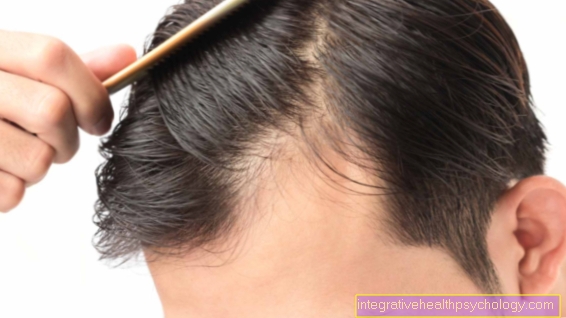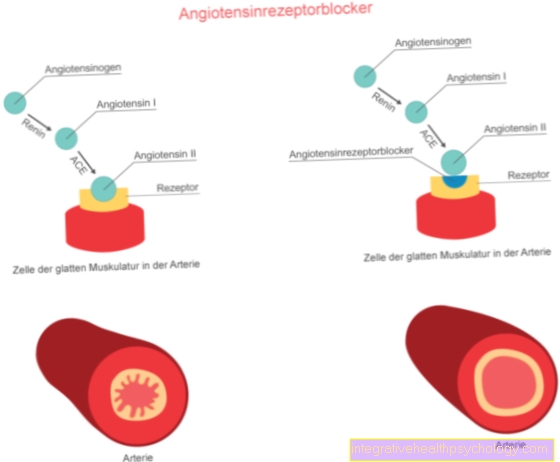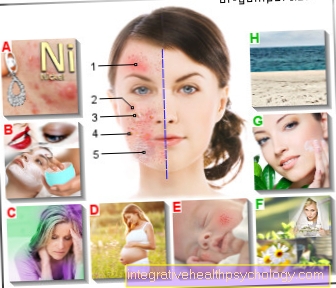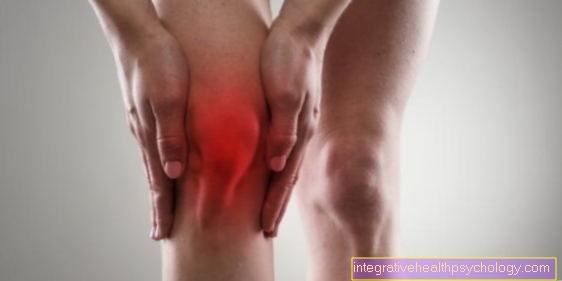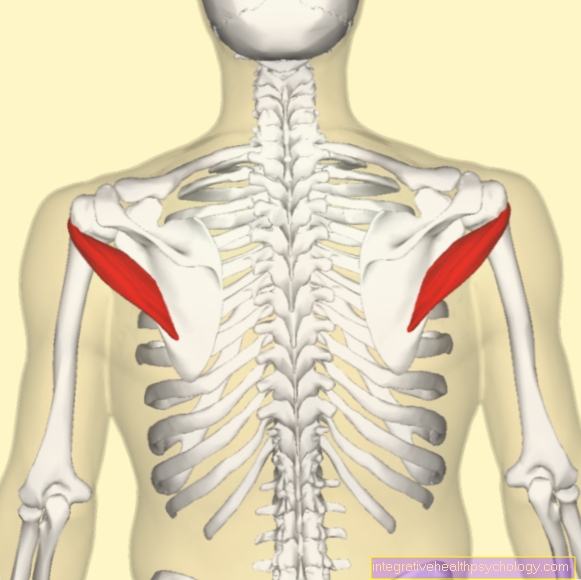Caries on the wisdom tooth
Introduction - What is tooth decay on the wisdom tooth?
In adolescence, tooth decay is the main cause of tooth loss. Tooth decay is a disease of the hard tooth structure caused by the interaction of several factors (especially bacterial plaque, food residues and poor oral hygiene). The position of the wisdom teeth as the last in the row of teeth makes cleaning difficult, so that tooth decay often occurs on the wisdom teeth and is unfortunately only noticed late.

Causes of tooth decay on the wisdom tooth
In general, all teeth in the mouth can be affected by tooth decay. If the tooth surface is not cleared of food residues and dental plaque, the metabolism of carbohydrates by the bacteria on the tooth surface leads to the formation of acids. These loosen the crystals from the superficial enamel (Demineralization).
Normally, the components of saliva ensure that the pH value rises and the acid attack is interrupted. The loosened enamel particles are built back into the tooth substance (Remineralization). Dental care products containing fluoride support remineralization and harden the tooth enamel.
If the balance between demineralization and remineralization shifts due to reduced saliva flow and inadequate oral hygiene for demineralization, so much hard tooth substance is loosened that a lesion (colloquially a hole) is created. Without therapy, this lesion continues to spread to the inside of the tooth until it reaches the pulp after the dentin and root inflammation occurs.
The wisdom teeth are the last teeth to break through at the end of the row of teeth. This area is often overlooked or not reached when brushing your teeth, so that tooth decay occurs unnoticed on the wisdom teeth. In addition, in many cases there is only an incomplete eruption of the wisdom teeth due to a lack of space. This makes oral hygiene even more difficult.
You can also find out more at:
- What causes tooth decay?
- How does tooth decay develop?
- Caries from breastfeeding
How is tooth decay diagnosed on the wisdom tooth?
The dentist makes the diagnosis after the inspection with a mirror and probe. In order to be able to estimate the extent of the carious lesion, an x-ray is usually made. There you can see the dissolved tooth structure as dark areas (translucency). During the dental examination, a sensitivity test and a tap test (percussion) can be used to determine whether the nerve in the pulp is already inflamed.
Read more about this under:
- How do you recognize tooth decay?
- X-ray image at the dentist
These symptoms can indicate tooth decay on the wisdom tooth
-
Pain
-
Discoloration
-
Loss of substance ("hole in the tooth")
-
unpleasant taste and bad breath
With advanced carious lesions, irritation of the dental nerve causes pain. Pain can occur especially when chewing or after consuming sweets. But not every caries disease is necessarily noticeable through pain.
Read accordingly: Toothache
For the layperson, the initial lesion is usually indistinguishable from healthy tooth structure. Only later does a dark discoloration occur.
The tongue is very sensitive. Loss of substance in the form of holes in the tooth due to advanced carious destruction is usually noticed very quickly by the patient.
The bacterial decomposition of food components and tooth substances creates putrid smells, which can show up as bad breath (even after brushing your teeth) and as an impairment of taste.
You can also find more information at: Symptoms of tooth decay
Wisdom tooth turns black
Demineralized tooth enamel has porosity in which color pigments from food (tea, coffee, red wine, fruit, cocoa, etc.) are stored. This is how the typical dark brown to black spots appear.
However, especially in smokers, there is discoloration of the tooth surface without any carious activity. The dentist can examine whether there is discoloration or a lesion.
While a dark caries lesion is usually older and less active, the fresh active caries appears whitish opaque. These initial lesions can only be seen after the tooth surface has dried. That is why they are often overlooked.
You might also be interested in: White teeth - remove stains
Wisdom tooth has broken off due to tooth decay
If the hard tooth substance is weakened to such an extent by extensive destruction through caries activity that the tooth crown becomes unstable, parts of the tooth can break off. Usually this affects the cusps that carry the chewing force.
However, tooth fractures can also occur independently of a caries disease.
For more information, see: Tooth broken off
How is decay on the wisdom tooth treated?
The therapy of a carious lesion depends primarily on the severity of the substance damage.
Initial lesions without loss of substance can be treated by promoted remineralization. The targeted application of highly concentrated fluoride varnishes is sufficient with intensified oral hygiene to treat superficially demineralized areas.
Read on accordingly: Fluoridation of teeth
As soon as the surface collapses, however, an increased supply of minerals is not enough. The carious lesion continues to spread and must be treated with invasive measures. The most common is the filling therapy, in which the cleaned lesion (cavity) is filled after removing the bacteria and the destroyed tooth substance. The most modern solution are composite fillings, but these are not covered by health insurance.
Learn more at: Removal of tooth decay
If the wisdom tooth has been severely damaged by caries, a crown can be useful.
In general, wisdom teeth are often removed because they often do not erupt completely or in the wrong direction due to lack of space. If tooth decay also occurs, tooth extraction (extraction) advisable.
Since no spread of caries is to be expected without bacterial plaque and a diet containing carbohydrates, better dental care should always be provided through oral hygiene instruction and demonstration at the dentist. Regular check-ups and, if necessary, professional tooth cleaning help to detect carious lesions at an early stage and prevent them from developing.
Read also under:
- Tooth decay treatment
- Can you cure tooth decay?
Seal on the wisdom tooth
The colloquial term “filler” means an amalgam filling. The substance defect on the wisdom tooth must be filled so that the tooth regains its shape and function and so that the dentin wound is covered. Only the tight seal reduces the nerve irritation and consequently the pain.
Amalgam is a filling material that has been used successfully for over 100 years and is still the standard service for definitive fillings in the posterior region of adults. The triumphant advance of tooth-colored composite fillings has largely replaced amalgam today.
The use of amalgam is also to be reduced in the future in order to reduce the environmental impact of mercury.
Read on under:
- Material of a tooth filling
- Tooth filling with cement
- Tooth filling with plastic
Crown on wisdom tooth
The further the carious lesion spreads, the more healthy tooth structure is lost. This weakens the stability of the tooth crown, so that a crown is necessary. This crown, made of metal alloy or ceramic, splinters the tooth, so to speak, and extends its retention in the mouth. Teeth that have undergone root canal treatment usually have to be crowned.
Pull wisdom tooth
The wisdom teeth are pulled very often. This is primarily not due to tooth decay but to its non-physiological situation.
If the wisdom teeth have been destroyed by caries to such an extent that it does not make sense to preserve them, they can be removed. However, this decision must be made carefully, as every tooth should be preserved for as long as possible, especially in caries-risk patients.
On the other hand, prophylactic removal can also be considered if the patient is unable to clean the wisdom teeth satisfactorily.
You can find more information about removing wisdom teeth at: Pull wisdom tooth
Prognosis for caries on the wisdom tooth
In general, the earlier it is discovered and treated, the more favorable the prognosis for the tooth concerned, with deep dentine caries involving the pulp being the least favorable, while small enamel caries is the least problematic.
That is why the back of the molars should be cleaned particularly well. This also applies to wisdom teeth that already have a filling or a crown, as in these cases the edge areas are prone to caries.
Regular check-ups at the dentist and careful oral hygiene offer the best long-term prognosis.










